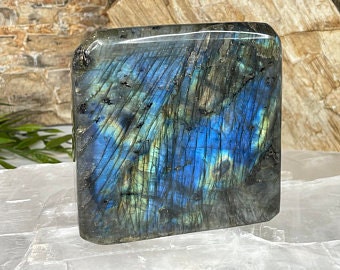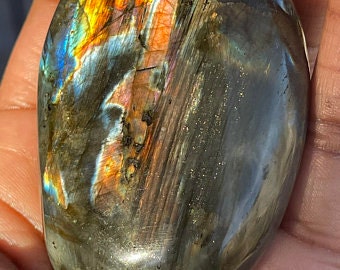Labradorite
is most commonly found in basalt and gabbro. Clasified as an mafic igneous rock, labradorite is a feldspar which can display an iridescent optical effect when held at various angles from a light source. Mafic rocks contain the contents of "basalt proliths and volcanic sediments" which are said to contain a variation of "iron, magnesium, calcium, silicon, and aluminum" (Britannica). Most labradorite slabs that you'll come across will have one polished side and one natural rough rocky-like side.

Click the video below to see a Microscopic view of a polished Labradorite gemstone!
Go to the video below to see a Microscopic view of Labradorescence in a polished Labradorite crystal!

Labradorite Palm Stone

Works Cited: Alexandra, Andrea (2020). Photography, Labradorescence on Labradorite. Alexandra, Andrea (2020). Photography, Labradorite displaying labradorescence. Alexandra, Andrea (2020). Photography, Close up of the surface of Labradorite, Microscopic views of Labradorite(3).e The Editors of Encyclopaedia Britannica. “Mafic Rock.” Encyclopædia Britannica, Encyclopædia Britannica, Inc., 20 July 1998, www.britannica.com/science/mafic-rock. “Definition of Labradorescence.” Mindat, www.mindat.org/glossary/labradorescence. MRL The Mineralogical Record - Library, mineralogicalrecord.com/libdetail.asp?id=164.
